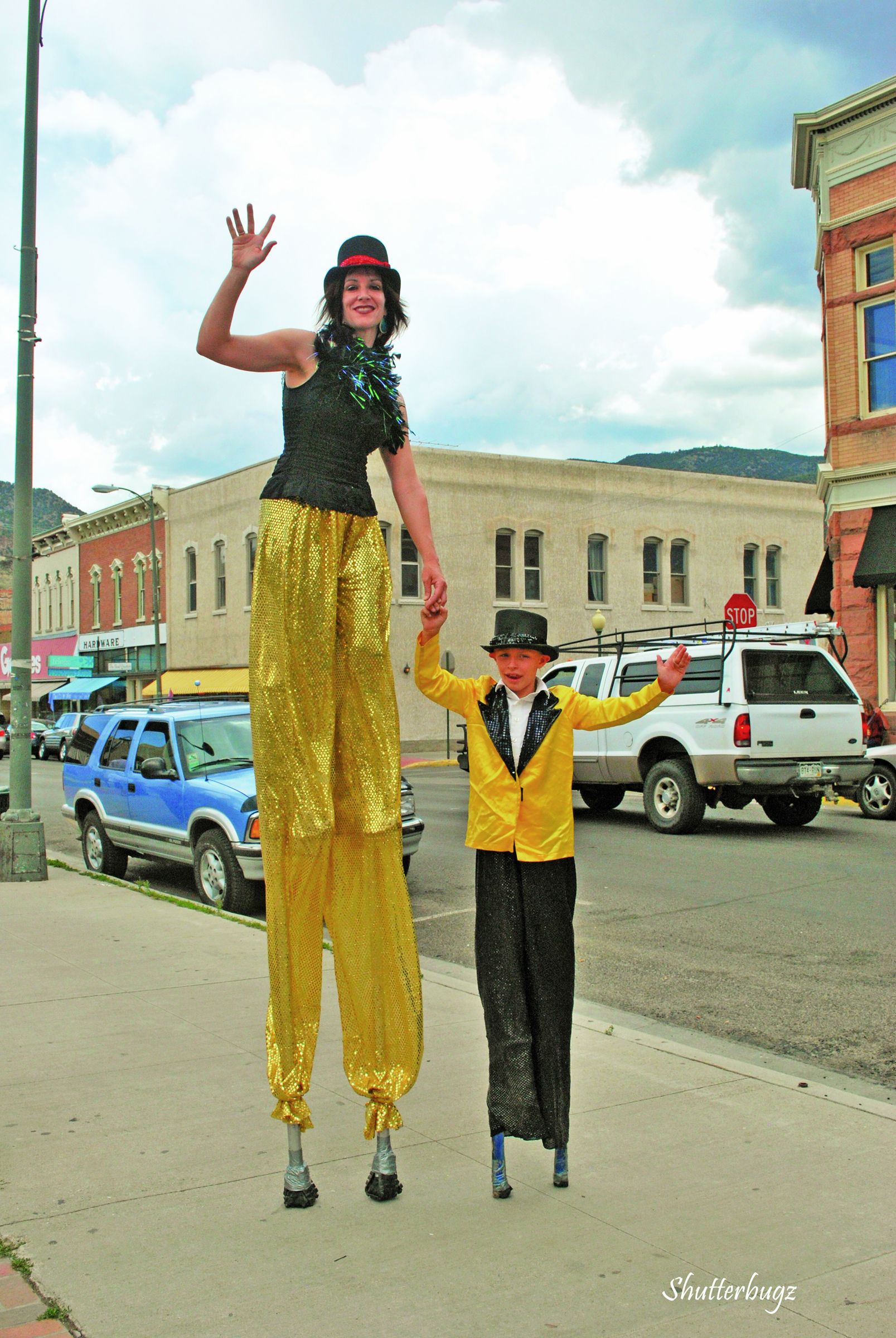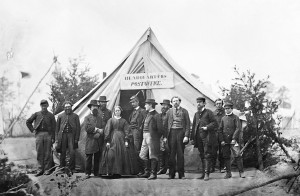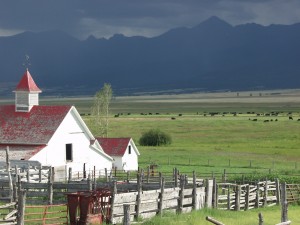By Nathan Ward
On a sunny day last summer, I looked up just in time to see a wildly tall woman stepping down F Street, a figure so tall that she had to bend down just to look in the tops of the downtown store windows. Then, acrobats raced by twirling, spinning, flipping heels over head. Then more clowns, young and old, short ones, tall ones and then unicycles spun by. The circus was in town!
The circus holds such a mythical place in human history that just the sight of circus people stirs the soul into an air of anticipation. I ran outside to greet the woman on stilts that turned out to be Jennifer Dempsey, founder of the Salida Circus. She was leading the entire local circus troupe to perform in the park and help raise awareness for Project Education Sudan, a non-profit that builds schools and hope in Southern Sudan.
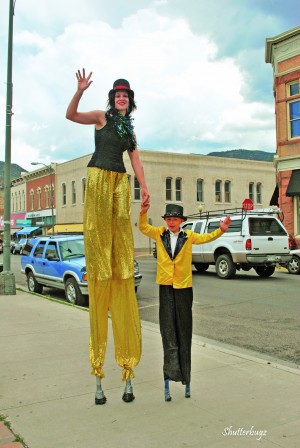
With 20 years of life on the circus road, Jennifer founded the Salida Circus in 2007, bringing the larger world to the Upper Arkansas River Valley and opening up a new world of possibility for local children and adults. In her mainstream clothes, Jennifer’s looks don’t hint at her vocation, but it’s easy to be drawn in by her warm eyes and quick smile. Plus, who can help but be drawn in by the story of a life spent in the circus?
Life as a circus performer can start by simply signing up for a workshop at the Salida Circus, and in a way, this is how Jennifer’s circus career began. She started to learn circus skills far from Salida, at Oak View Elementary in Fairfax, Virginia, where a phys-ed teacher named Jim Moyer ran an after-school circus program funded with his own money.
Jennifer participated in the program from age eight to 12 with her two brothers and two sisters, performing hundreds of shows a year around the Washington D.C. area. As Jennifer went on to pursue a career in writing, the circus years were left behind as a sweet childhood memory.
But that all changed during a junior year to study abroad at Queens University in Belfast, Northern Ireland. One day while leaving an Irish literature class, a flyer advertising a workshop with the Belfast Community Circus in a nearby church caught her eye and she walked straight to it. Call the rest fate: Jennifer soon left the university to work with the circus full time.
Belfast in the late 1980s and 1990s wasn’t the most peaceful place on Earth. Sectarian violence ripped through the city as paramilitary groups fought over political and religious differences. Throughout all this, the Belfast circus continued and even served as a form of catharsis as children from opposite sides of the conflict came together to experience the fun of circus life. Catholics and Protestants lay aside their dislike and fear of each other to learn the double crab, plate spinning, unicycle riding, clowning and juggling.
For Jennifer, the importance of working together in the circus became very clear on Saturday, October 23, 1993. She had been working as the Art Director of the Belfast Community Circus School for just a short time and this was the night of their first performance. It was also the day that became infamous for the Shankill Road bombing when the Irish Republican Army blew up Frizzell’s Fish Shop, claiming a Loyalist meeting was taking place above the shop. Ten people were killed and sent the city into an uproar.
Amid the chaos, most people would have pulled down the curtains and called the show off. However, Jennifer decided that the show must indeed go on and the 26 children and three adults in the program that night showed up full of nerves and anticipation, ready to go onstage. The show wasn’t flawless, but it brought the crowd to their feet and the children left beaming and proud.
This ability to bring different factions together in times of struggle is just one of the powers of the circus and emphasizes again the often overlooked fact that community arts are not just empowering for individuals, but can be healing for communities, thus the concept of “circus with a purpose”.
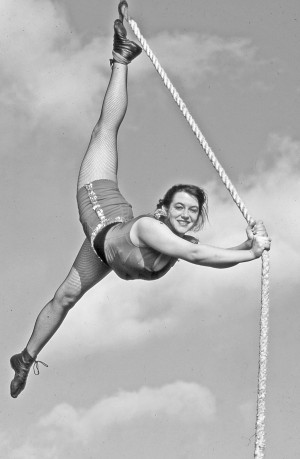
For Jennifer personally, it was a decisive choice in life that she sums up 18 years later, “Why stop the joy of the positive things and give power to all the bad things? For those children and adults involved in the circus, the memory of October 23 will be a good one.”
Jennifer worked in the circus for 12 years in Northern Ireland before moving on to perform in Circo Rum Ba Ba in London and with the Scarlet Sisters Circus in California. Besides teaching, her tools of the trade grew to include walking on stilts, juggling sharp objects, riding a unicycle, swinging on the trapeze and partnering in doubles acrobatics. Not your normal bag of tricks.
When I caught up with Jennifer, we talked about the power of her bag of tricks. “Circus gives me a real sense of freedom. I can go anywhere in the world with these skills,” she smiled. Having circus skills is like having a magic passport, the passport of circus. It opens doors to worlds that one would never be able to enter any other way and Jennifer’s list of passport moments is long – performing for Prince Charles, at Elton John’s birthday party, at the Hollywood Bowl, the Rose Bowl and on the White House lawn.
The circus has also taken her to festivals in France, Wales, Mexico and most recently to Guatemala where she worked with La Cambalacha, a Mayan children’s circus program in San Marcos.
It’s a world that seems far from Chaffee County, but a few of her students are already pursuing similar opportunities. Salida Circus co-director Manda Ellison is heading to the circus in Belfast and plans are in the works for a couple of teenage tutors to head to Newcastle, England, to work with Let’s Circus.
However one doesn’t have to run away to an exotic locale to tap into the magic of the circus, the benefits of the circus can be realized right here at home.
“Circus is a world unto itself. The stage is an entirely neutral setting. You leave your ego and identity at the door. It doesn’t matter what you do in the world outside the circus ring, once you step into that space, everyone is equal and the only thing that matters is your ‘circus spirit’ or willingness to be open,” explains Jennifer.
“That is why it can be so transformative. It’s different than traditional sports in that it’s non-competitive. We’ve always tried to create a nurturing, supportive environment where young people can discover talents they didn’t know they had, talents that can reveal a whole new side of themselves.”
Welcome to a reality where jugglers are the popular people. Where eccentrics are looked at not as strange, but as strength. Children can grow deeper by using circus to move outside of the box. Adults can grow more mirthful by using clowning to swipe at the seriousness of things. All it takes is to open your mind to another reality and then use your feet to walk through the door.
Jennifer left me with this, “We’re looking for another stilt walker. You should come by and join the circus.” How is that for opening up a world of new possibilities?
Nathan Ward is a professional writer and photographer who has flirted with the circus more than once. One of his favorite travel memories is having lunch with overly-limber contortionists from the Mongolian National Circus while on assignment in Central Asia. He is considering taking up stilt walking as a side act. See Nathan’s work at www.NathanWard.com

